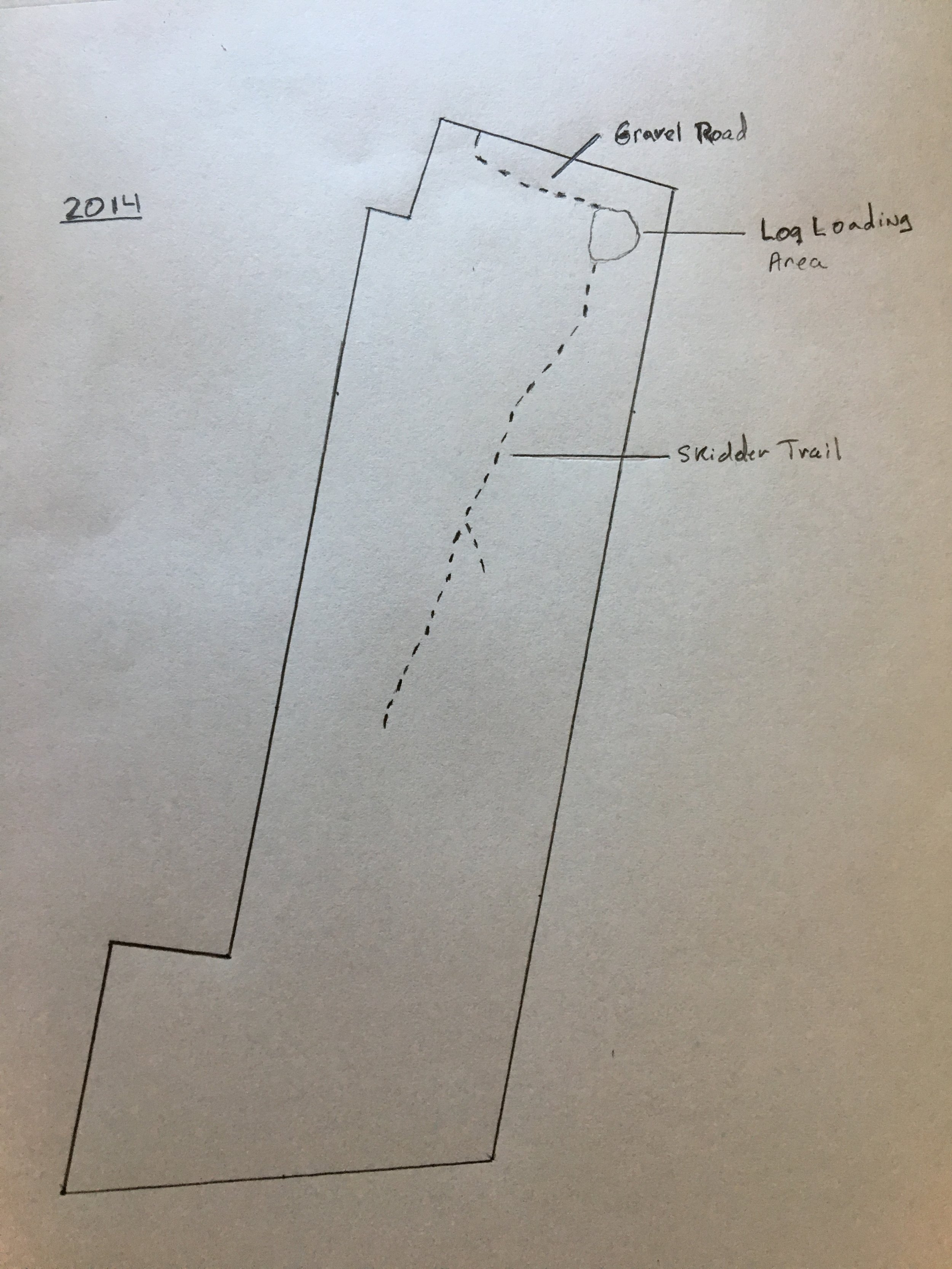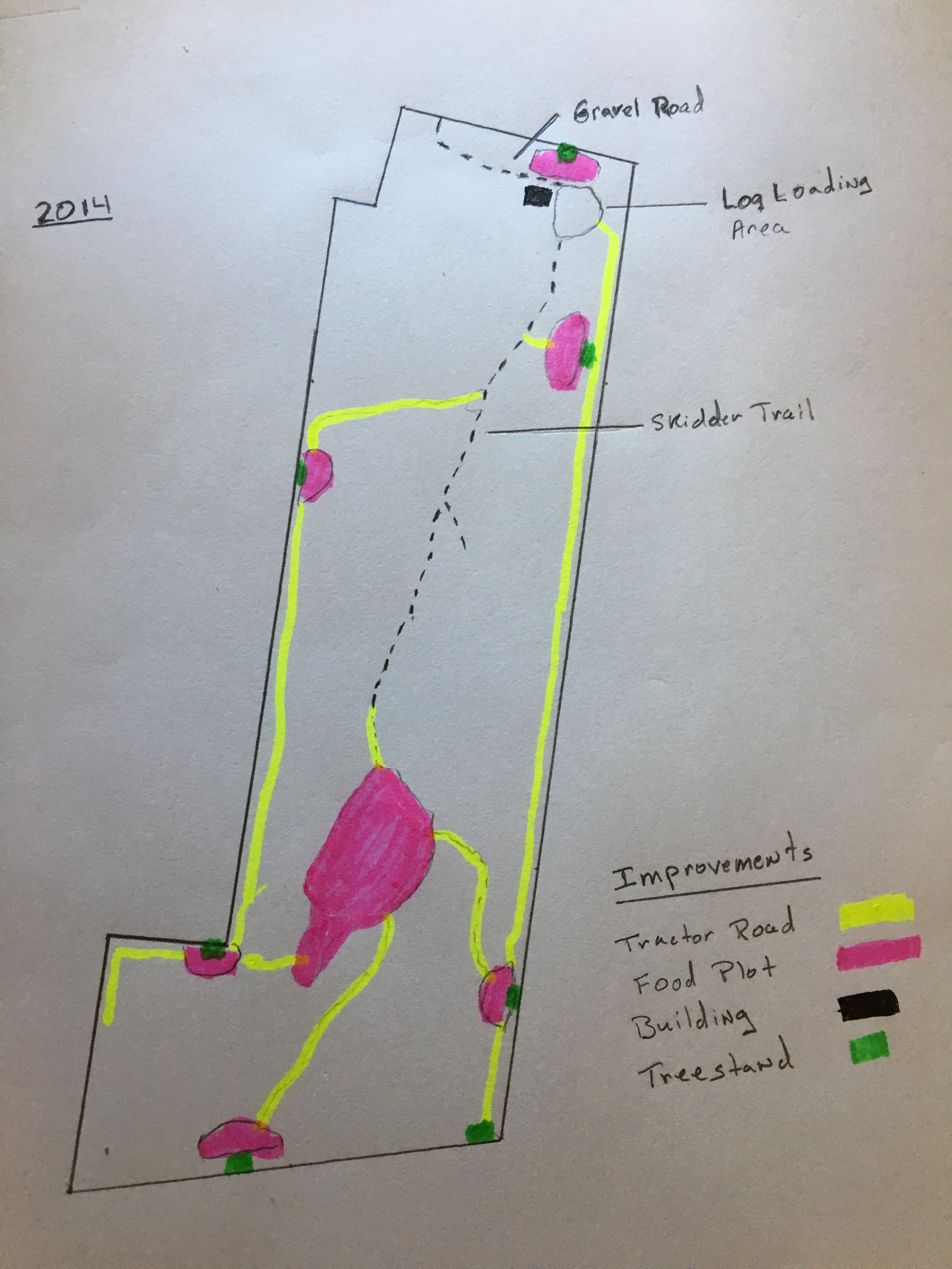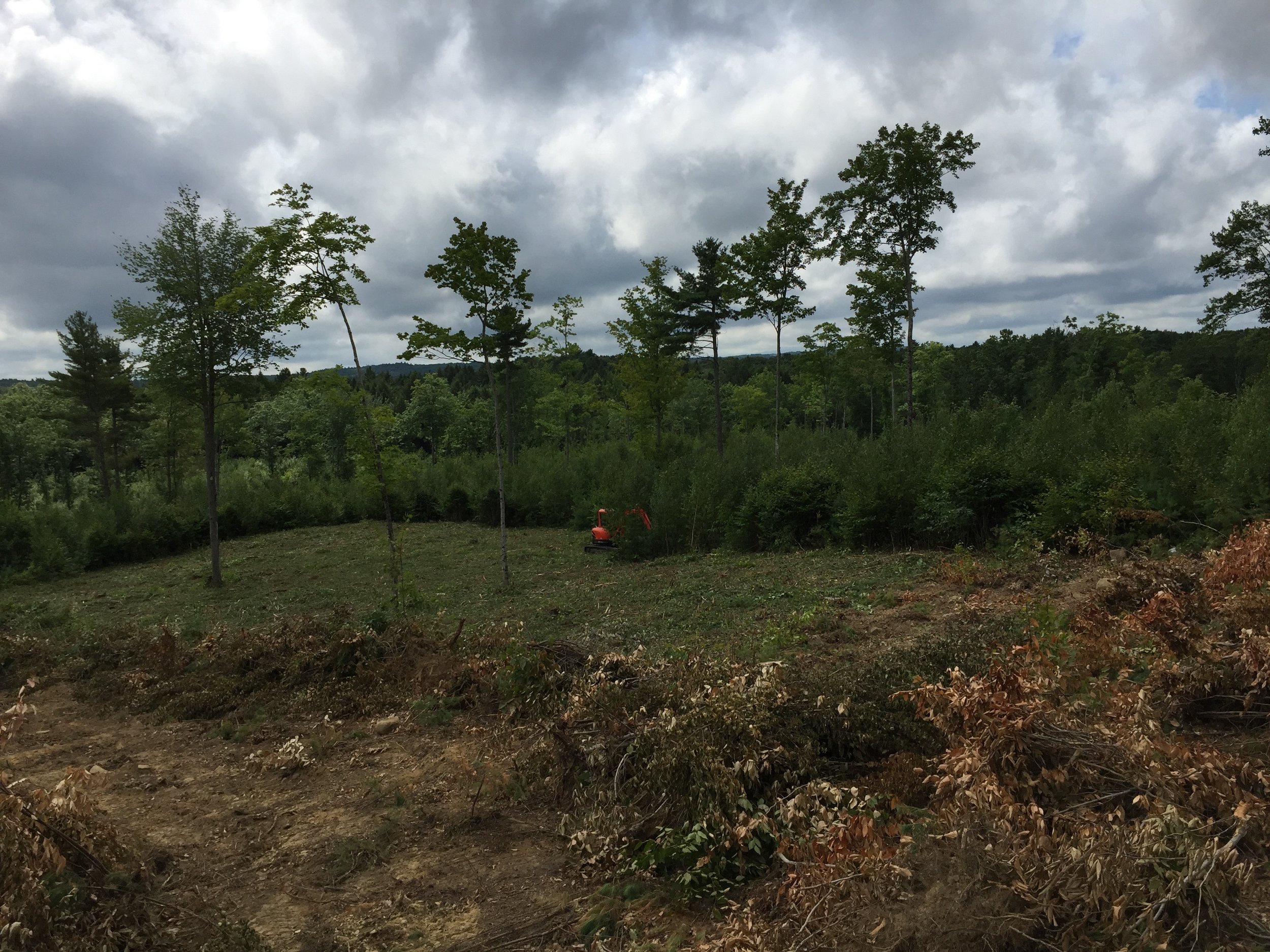2014 and 2015 Land Management Case Study
House and field surrounded by cuttings and power lines
I built a house on 20 acres of land in southern Maine in 1995, and it was there that my passion for managing land for deer hunting began to take shape. The land was surrounded by thousands of acres of woods and cuttings, agricultural fields, power lines, and low-density housing. I planted clover in the three acres across from the house, put up tree stands in the woods, and created hinge-cut barriers to direct the deer travel past my stands.
My land happened to be in the Portland Expanded Archery Zone, which allows a longer hunting season and a more generous bag limit. I could hunt with a bow from September to December, and over the years the limit was increased from two deer to one buck plus unlimited numbers of does - in addition to the one buck allowed by a regular Maine big game license. Maine’s Department of Inland Fish and Wildlife created the Expanded Archery Zones with the goal of controlling the whitetail deer population in areas where gun hunting was limited by a large number of houses. I very quickly became a passionate bowhunter.
To read my article about harvesting a morning two-fer on my Portland Expanded Archery land, click here.
The new 61 acre parcel
As I was planning to move to central Maine in 2014, I started looking for a parcel of land that would give me great hunting opportunities, and enable me to take my land management skills to the next level. I used the landwatch.com website to search by county or town for undeveloped land. The Landwatch site allows your search to rank parcels in decending order of acreage, so you can find the larger tracts. Looking in both the Waterville Expanded Archery Zone and the Augusta Expanded Archery Zone, I found that most of the parcels of undeveloped land were small - the result of more than 200 years of subdividing. However, after months of looking, I spotted a good size chunk for sale and bought it for about the price of a high-end pickup truck.
The parcel was 61 acres of raw land that had been logged about seven to ten years previously, and was thick with hardwood regeneration saplings that were about 10 feet tall. Every 50 feet or so a red oak or maple had been left, usually about 10 to 12 inches in diameter. The parcel was in the shape of a boot, with stone walls, a rocky ridge running down the middle, and in a few places along the property line a large tree or two had been left. The deed went back to the 1830s referencing a “bubbling spring” that neighbors could use to water their livestock which, along with the stone walls and soil quality, led me to believe that it had been used for grazing, not for row crops. It wasn’t ideal for my purposes because the quantity of rocks and exposed ledge would limit where I could put in food plots, and there was a shortage of trees suitable for stands. However, the location was good and the price was right. It was also in the part of the city where a local ordinance prohibits firing a gun except in self defense - a bonus for bow hunters!
The management plan for 2014 and 2015
I closed on the land in the summer of 2014 and started to develop a plan. I walked the land to get a feeling for it - it was so thick! Bushwhacking through close saplings limits your perspective, but combining that with the view from Google Maps enabled me to get a pretty good idea of what the soil was like, where I could establish food plots, bedding areas, stands, roads, trails, etc. I wanted a crude road around the perimeter of the parcel that I could use for tractor and hunting access, small “harvest” food plots around the property line where there were suitable trees to hunt from, a large food plot in the middle to keep deer on my land, and tractor access up the middle. Everywhere else that would not be a food plot or a road would be a thick bedding area where the deer would feel safe during the day.
As 2014 came to a close I felt like I had a good plan, so I started on the perimeter tractor road. I walked the property line, flagging where I wanted the road to go. You can see in the plan that the south and southwest border do not have a road - that is because the ground is wet in those areas and I did not want to bring in fill material. I hired an excavator and operator from McGee Construction to clear the perimeter road, which he did in two days during the fall of 2014. I put up a tree stand in the southeast corner and hunted it a couple times, seeing four does out of bow range during one of my sits - they were bedded in the thick saplings to my west. On my way in to the stand I also saw a gun hunter in orange on the abutting property. Yes, gun hunting is against the law in this area and that was one of the things that attracted me to the land, but apparently the locals didn’t know that - I hoped it wouldn’t become a problem. I finished the year by flagging the remaining tractor roads and food plots. After the hunting season was over and the leaves were off the trees, it was easier to see what the land was like and where everything should go.
Raising the barn that would store my equipment
In 2015 I hired my friend Todd (Todd Harrison Construction) to build a pole barn up by the old log loading area so I could have a place to keep my equipment. After grubbing out a spot for the barn and a vegetable garden, Todd used his excavator to start work on the large food plot. We went up the existing skidder road until it petered out, and then headed over the crest of the ridge (that I later named Buck Ridge), clearing a rough road as we went - Todd on the excavator and me on my tractor with my rock grapple bucket on the front. He was pulling out stumps and saplings, setting them aside, and I used the grapple to try to move them out of the way. It was tough going as the saplings were 10 to 15 feet high and soon clogged our progress.
It didn’t take long before we decided that the job was too big for a medium-sized excavator alone. Todd suggested we shift gears and contract a friend of his to clear the land using an excavator brush cutter, which is essentially a beefed-up hydraulic bushhog on the boom of a small excavator. We did that, along with a bulldozer to grub out the stumps and rocks and move them to the side of the food plot.
Excavator brush cutter cutting saplings in Big Clover plot
I learned a tough lesson in 2015. The ground in much of this parcel, especially where I was locating the large food plot, was a thin layer of topsoil over dirty gravel. The bulldozer didn’t have a rake-blade, the operator wasn’t sensitive enough to the gravel issue, and neither was I, so what I ended-up with was a food plot with poor soil - not enough organic material - especially on the uphill side. The large food plot was partially on a slope, and the topsoil was bulldozed off the slope, collecting below on the section that was more level. A lot of good topsoil was also used to bury the stumps.
Organic material is an essential component of soil because it helps retain moisture and it’s full of nutrients. If I could go back and do the land clearing again, I would use the brush cutter as we did, but follow-up with an excavator to grub out the stumps and rocks - if I had just removed the stumps and rocks, I would have left much more topsoil. The bulldozer was too crude a tool to selectively move just the unwanted stuff out of the plot, and retain the organic material needed to have healthy soil.
Landscape rake collecting roots and rocks
The smaller harvest plots had vastly different soil conditions. One had good topsoil, another was weaker and was getting a lot of shade, two had wet areas, and another was dominated by rocks and exposed ledge. The harvest plot at the northern property line near the barn had not been worked by the brush cutter or bulldozer because it was less overgrown - I would work on it with just the tractor in 2016. I chose the location of the harvest plots because they were near the property line and allowed me to get in and out undetected, the ground was reasonably ok for food plots, and they had older trees that were suitable for tree stands. Managing land for hunting is a series of compromises - if the land had different soil, trees, and shape, I would have located the food plots and treestands differently, but this was what I had to work with. After the bulldozer was finished I used my landscape rake to smooth the food plots and remove the roots and rocks. Looking back at the project, a Harley Rake could have been used at this point to more easily remove the rocks while leaving the soil behind.
Working the Big Clover plot with disc harrow
The sloped upper-third of the large plot was little more than gravel and rocks, and after working it for a while I decided to let it go fallow as I concentrated on the two thirds that was closer to level and had better soil. It didn’t help that I scared the crap out of myself by carelessly turning the tractor around on the upper slope with the bucket raised and tipped up on two wheels! After that close call, I will never underestimate the danger involved in working with my tractor on sloped ground.
I finished 2015 with my food plots prepped for the next year, my tractor roads complete, and by hanging tree stands overlooking the harvest plots. I hunted my land a few times without seeing any deer, but I didn’t expect any results yet because I didn’t have all the pieces of the puzzle in place. The Polaris Ranger EV electric UTV I purchased that year helped me hunt without making a lot of noise (see my review of the Ranger EV by clicking here). I knew that deer were bedding on my land because I’d seen the signs, but it couldn’t yet hold a significant population because it didn’t have much food. Does like to bed close to their afternoon food source, and bucks farther away because of “social stress” - they do not want to be bothered by other deer.
My Colorado archery bull elk
The land to the south was mature hemlock and white pine with very little browse growing at deer level, and no cover for bedding. East and west had good mast producing oaks, some wild apple trees, some browse, but not a lot of bedding cover. To the north was a small old field and a road with houses along it, and some pasture land farther north. My land was thick, obviously good bedding cover, and much of the surrounding land would have good browse and mast trees, but I didn’t see defined travel corridors, staging areas, and funnels. Instead of hunting on my land, I freelanced with my climbing tree stand on other property nearby, and took a couple hunting trips out of state. A Colorado elk filled my freezer in 2015.
To find out what happened next, check out: 2016 Land Management.







